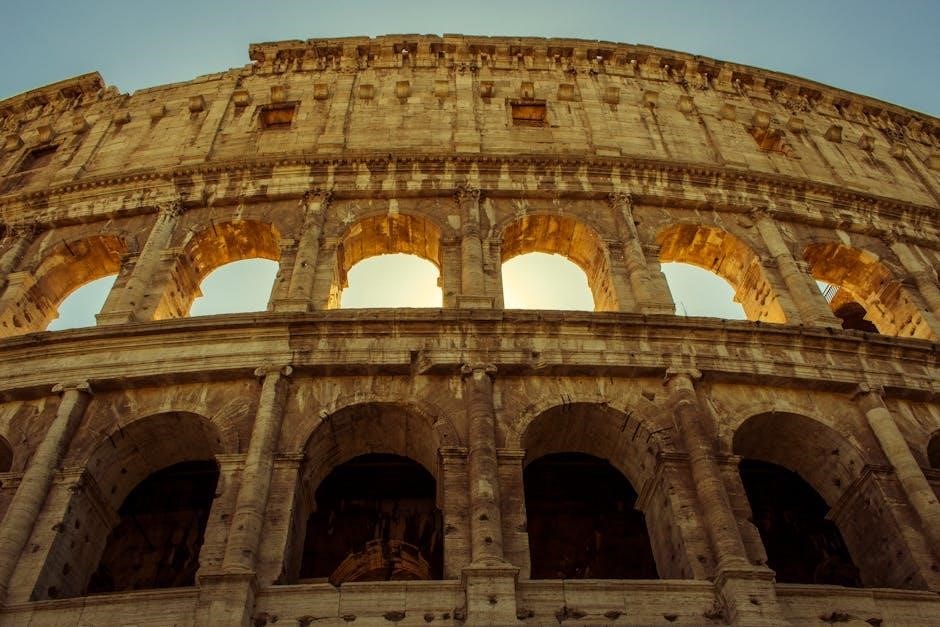decline and fall of the roman empire pdf
Edward Gibbon’s monumental work explores the decline of the Roman Empire, offering a detailed historical account spanning over a thousand years․ The PDF version provides easy access to this comprehensive study, available for free download from sources like the Christian Classics Ethereal Library and Project Gutenberg, ensuring its accessibility to modern readers․
1․1․ The Significance of Gibbon’s Work
Gibbon’s “The History of the Decline and Fall of the Roman Empire” is a monumental work of historical scholarship, blending meticulous research with masterful narrative․ Its comprehensive analysis of the Roman Empire’s rise, peak, and fall remains foundational, offering insights into political, social, and military dynamics․ The PDF version ensures accessibility, preserving its enduring influence for modern readers․
1․2․ Structure and Content of the PDF Version
The PDF version of Gibbon’s work is meticulously organized into multiple volumes, with each volume focusing on specific periods and aspects of the Roman Empire’s history․ The documents include detailed chapters, historical analyses, and references, providing a comprehensive overview․ The digital format enhances readability, making the extensive historical account accessible and convenient for modern scholars and readers alike․
1․3․ Key Themes and Insights
Gibbon’s work explores the Roman Empire’s decline, emphasizing political instability, military overextension, and economic troubles․ It highlights the transition from paganism to Christianity and internal decay’s role in the empire’s fall․ The PDF version offers insights into corruption, barbarian invasions, and societal shifts, providing a comprehensive understanding of the empire’s vulnerabilities and legacy․
Historical Context of the Roman Empire’s Decline
The Roman Empire’s decline began after its peak in the 2nd century AD, marked by internal instability, external pressures, and economic strain․ The PDF version of Gibbon’s work provides a detailed account of this transformation, highlighting the complexities of its fall and legacy․
2․1․ The Rise and Peak of the Roman Empire
The Roman Empire reached its zenith in the 2nd century AD, characterized by extensive territorial expansion, military dominance, and the establishment of a sophisticated legal and administrative system․ The PDF version of Gibbon’s work details this golden era, highlighting the empire’s cultural achievements and the foundation that eventually led to its complex decline․
2․2․ Key Events Leading to the Decline
The decline of the Roman Empire was precipitated by internal strife, including civil wars and political instability․ External pressures such as barbarian invasions and economic strain further exacerbated the situation․ The PDF version of Gibbon’s work meticulously documents these pivotal events, providing a comprehensive timeline of the empire’s gradual deterioration and eventual fall․
2․3․ The Fall of the Western Roman Empire
The Western Roman Empire officially fell in 476 CE when Odoacer deposed Emperor Romulus Augustulus․ This event marked the culmination of centuries of decline, triggered by internal decay, economic strain, and relentless barbarian invasions․ The PDF version of Gibbon’s work vividly captures the final stages of the empire’s collapse, highlighting the sack of Rome by the Visigoths in 410 CE and the eventual fragmentation of authority․

Causes of the Decline and Fall
The decline of the Roman Empire stemmed from political instability, military overextension, economic decay, and internal corruption․ The PDF version of Gibbon’s work provides a detailed analysis of these factors․
3․1․ Political Instability and Corruption
Political instability and corruption were central to the Roman Empire’s decline․ Gibbon’s PDF highlights how frequent regime changes, mismanagement, and bribery eroded governance, leading to internal decay and external vulnerabilities, as detailed in his comprehensive analysis available online․
3․2․ Military Overextension and External Pressures
Gibbon’s analysis emphasizes how military overextension drained Rome’s resources, while constant barbarian invasions and border pressures weakened its defenses․ The empire’s vast territories became difficult to maintain, leading to strategic vulnerabilities․ PDF versions of Gibbon’s work detail these challenges, highlighting how external threats exacerbated internal instability and hastened the empire’s collapse․
3․3․ Economic Decline and Inflation
Economic decline and inflation severely impacted the Roman Empire, as outlined in Gibbon’s work․ Agricultural productivity decreased, while population decline led to labor shortages․ Inflation, caused by currency debasement, further destabilized the economy․ PDF versions of Gibbon’s history detail how these factors, combined with excessive spending, eroded the empire’s financial foundation, accelerating its downfall․
Military Factors in the Decline
The Roman Empire’s military decline stemmed from overreliance on mercenaries and barbarian invasions․ PDF sources reveal how military overextension and internal instability weakened its defense capabilities, accelerating its fall․
4․1․ Overreliance on Mercenaries
The Roman Empire’s reliance on mercenaries significantly contributed to its decline․ Hiring external forces reduced military loyalty and increased costs․ This practice weakened the empire’s defense capabilities, making it vulnerable to internal instability and external invasions, as detailed in historical PDF sources․
4․2․ Barbarian Invasions and Military Weakness
Barbarian invasions exposed the Roman Empire’s military vulnerabilities․ Frequent breaches of borders drained resources and destabilized governance․ The empire’s weakened military, plagued by corruption and poor leadership, struggled to repel external threats; These invasions, coupled with internal instability, hastened the empire’s decline, as documented in historical PDF analyses of the Roman Empire’s fall․
Social and Cultural Changes
The decline of the Roman Empire was accompanied by significant social and cultural shifts․ Traditional Roman values eroded, while Christianity’s rise reshaped societal norms, as explored in Gibbon’s work․
5․1․ Decline of Roman Values and Morality
The decline of Roman values and morality contributed to the empire’s fall․ Traditional virtues like civic duty and discipline eroded, replaced by corruption and decadence․ Gibbon highlights how moral decay weakened societal cohesion, exacerbating internal instability and external pressures․ The rise of Christianity further transformed societal norms, shifting focus from earthly grandeur to spiritual pursuits․
5․2․ Impact of Christianity on Roman Society
Christianity’s rise reshaped Roman society, shifting values from state-centric to faith-focused․ Gibbon argued that this shift diverted loyalty from the empire, reducing military and civic engagement․ The church’s influence grew, while traditional Roman institutions declined․ Christianity introduced new moral frameworks, altering social dynamics and contributing to the empire’s transformation and eventual fall, as noted in Gibbon’s analysis․

Environmental and Demographic Factors
Environmental changes, such as climate shifts and agricultural decline, alongside population decrease and labor shortages, played a critical role in the empire’s instability and eventual decline․
6․1․ Climate Change and Agricultural Decline
Climate change and shifting environmental conditions led to reduced agricultural fertility and water scarcity, exacerbating food shortages․ This decline in productivity destabilized the Roman economy and society, weakening the empire’s foundation and contributing to its gradual collapse․
6․2․ Population Decline and Labor Shortages
Population decline, driven by diseases like the Antonine Plague, warfare, and economic hardships, led to labor shortages; This reduced agricultural output and impaired military recruitment, weakening the Roman economy and its ability to sustain extensive territories, ultimately contributing to the empire’s vulnerability to external pressures and internal instability․

The Legacy of the Roman Empire
The Roman Empire’s legacy endures through its cultural, legal, and architectural contributions․ Its influence is evident in modern governance, language, and law, shaping civilizations globally․
7․1․ Cultural and Legal Contributions
The Roman Empire’s cultural and legal legacy endures, influencing modern societies․ Roman law laid the foundation for many legal systems, while Latin became the basis for numerous languages․ Architectural innovations, governance structures, and cultural practices continue to shape contemporary civilization, ensuring the empire’s enduring impact on global development and intellectual heritage․
7;2․ Lessons for Modern Empires
Gibbon’s analysis of the Roman Empire’s decline offers timeless lessons for modern empires․ Factors such as political instability, military overextension, and economic strain are recurring themes․ The rise of bureaucracy and corruption, as well as the impact of external pressures, serve as cautionary tales for contemporary powers, emphasizing the importance of sustainable governance and adaptability in maintaining dominance․

The PDF Version and Its Accessibility
The PDF version of Gibbon’s work is widely available online, with free downloads from sources like the Christian Classics Ethereal Library and Project Gutenberg, ensuring easy access․
8․1․ Availability of the PDF Online
The PDF version of Gibbon’s The History of the Decline and Fall of the Roman Empire is readily available online through platforms like Google Books, Project Gutenberg, and the Christian Classics Ethereal Library․ These sources provide free access to all six volumes, making it accessible to a global audience for educational and scholarly purposes․
8․2․ Free Resources and Download Options
Multiple websites offer free PDF downloads of Gibbon’s work, including Project Gutenberg and the Digital Library of India․ Readers can access all six volumes in formats like PDF, ePub, and Kindle, ensuring compatibility with various devices․ These resources are invaluable for students, researchers, and history enthusiasts seeking comprehensive insights into the Roman Empire’s decline․
Modern Relevance of the Topic
The study of the Roman Empire’s decline remains relevant today, offering insights into environmental change, political instability, and societal transformation, all of which resonate with contemporary global challenges․
9․1․ Scholarly Interest in the Decline and Fall
Scholars continue to explore Gibbon’s work, drawn to its meticulous analysis of the Roman Empire’s decline․ The availability of the Decline and Fall in PDF formats has facilitated easy access, enabling researchers to study its insights on political instability, environmental change, and societal transformation, making it a cornerstone of historical scholarship and contemporary academic discourse․
9․2․ Applications to Contemporary Historical Studies
Gibbon’s work remains a foundational text for understanding imperial dynamics and societal transformations․ Its analysis of political instability, military overextension, and cultural shifts offers valuable insights for studying modern empires and global changes․ The PDF format ensures accessibility, making Gibbon’s timeless lessons relevant for contemporary historians examining parallels between ancient and modern declines of power structures․
Gibbon’s work provides a comprehensive analysis of the Roman Empire’s decline, offering timeless insights into historical patterns․ The PDF format ensures accessibility, preserving its relevance for modern scholars and readers alike, while highlighting the enduring legacy of Gibbon’s monumental historical account across centuries․
10․1․ Summary of Key Points
Gibbon’s “Decline and Fall” provides a sweeping narrative of the Roman Empire’s rise, peak, and eventual collapse․ The PDF version, spanning multiple volumes, offers a detailed analysis of political instability, military overextension, and societal changes․ It remains a foundational text in historical scholarship, with its digital format ensuring accessibility for modern readers and researchers, preserving its timeless insights into one of history’s most pivotal events;
10․2․ Final Thoughts on the Importance of Gibbon’s Work
Gibbon’s “Decline and Fall” remains a landmark study of the Roman Empire’s collapse, offering profound insights into political, military, and social dynamics․ Its meticulous research and engaging narrative continue to influence historical scholarship․ The PDF version ensures its accessibility, making Gibbon’s timeless analysis available to modern readers, solidifying its role as a foundational text in understanding ancient and modern civilizations alike․

